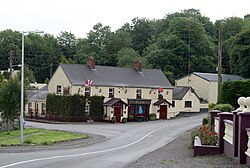Mount Temple, County Westmeath
|
Mount Temple An Ghrianán
|
|
|---|---|
| Village | |

The Village pub and restaurant
|
|
| Location in Ireland | |
| Coordinates: 53°23′42″N 7°42′58″W / 53.395°N 7.716°WCoordinates: 53°23′42″N 7°42′58″W / 53.395°N 7.716°W | |
| Country | Ireland |
| Province | Leinster |
| County | County Westmeath |
| Dáil Éireann | Westmeath |
| Population (2006) | |
| • Total | 525 |
| Irish Grid Reference | N182383 |
Mount Temple (Irish: an Grianán) is a village in County Westmeath in Ireland, about 6.5 km northwest of Moate. The village is best noted for its golf course of the same name. It was historically called Grenan and Ballyloughloe. Mount Temple and its 'sister' village, Baylin (or Baelin), form the only two in the parish of Ballyloughloe (often referred to as Caulry or Mount Temple). Its postal address is Mount Temple, Moate, County Westmeath, Ireland.
In ancient times, the locality of Mount Temple and its Hinterland formed part of the kingdom of the Ard Rí of Uisneach at Killare. The area of South Westmeath and Longford was conquered by Niall of the Nine Hostages circa 400AD and formed the Kingdom of Teathbha (anglicized Teffia). An area roughly the present-day parish of Ballyloughloe was granted to his son, Maine and was known as the Calraighre an Chalaidh, hence the name Caulry. It was ruled by Maine’s descendents for the next 1200 years. They were the MacAmhalgaidhe (Englished as Magawley or sometimes McAuley) and were referred as the Lords of Carlee in old manuscripts. The chieftain of their clan was inaugurated on a coronation site known as Tullymagawley, in the townland of Ballymurray.
The Hanevys, Geraghtys and Flynns are clans closely associated with the Magawleys, residing in the area. The principal neighbouring clans were the Melaghlins (Moate & Farnagh), Foxes (East Moate), Dillons (Kilkenny West), the O’Dalys and O’Malones (Castledaly) and the O’Braoins (East Athlone).
Tradition records that St Patrick visited the area in the 5th century, but was given a hostile reception in Caulry. He escaped to Annagh and onto Ballykeeran, where he reputed to have placed a curse on the people of Caulry. St Ciarán has strong associations with the area, having founded a church called Iseal Chiarán in Baylin. The Baylin High Cross (circa 800AD) originates from this site. A Franciscan Abbey and a St Clare’s Nunnery were located in the townland of Monksland, but they were abandoned following Henry VIII’s Dissolution of the Monasteries.
The Normans arrived in Ireland, via Wexford in 1171, and following a rapid conquest, arrived in this locality, led by the Tuites in 1180. They were responsible for the construction of a motte and bailey on top of an existing esker, the Garbh Esker that runs from the east to the village. Other Normans arrived under the Tuite’s leadership and many of those surnames remain in the area to this day, such as Nugents, Ledwiths, Daltons, Tyrrells, Pettits and Brownes. The Magawleys were never driven from the area and they regained control from the Tuites by 1362.
...
Wikipedia

